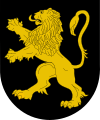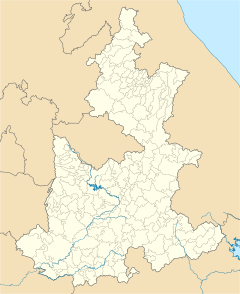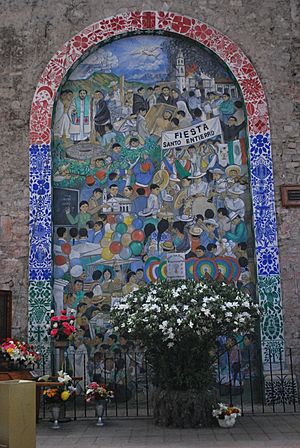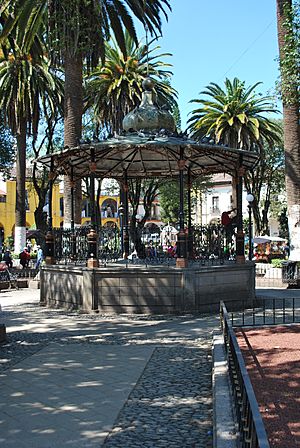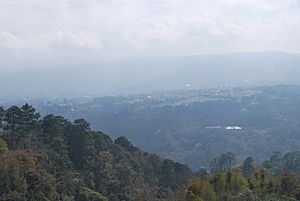Huauchinango facts for kids
Quick facts for kids
Huauchinango
|
||
|---|---|---|
|
City
|
||
| Huauchinango de Degollado | ||

View of Huauchinango
|
||
|
||
| Country | ||
| State | Puebla | |
| Founded | 1116-1121 | |
| Municipal Status | 19th century | |
| Elevation
(of seat)
|
1,519 m (4,984 ft) | |
| Population
(2010) Municipality
|
||
| • Municipality | 97,753 | |
| Time zone | UTC-6 (Central (US Central)) | |
| Postal code (of seat) |
73160
|
|
| Area code(s) | 776 | |
Huauchinango (officially Huauchinango de Degollado) is a city in the northern part of the state of Puebla in central Mexico. It is nestled in the rugged Sierra Norte de Puebla mountains. This area is known for its many peaks, deep valleys, and rivers that create beautiful waterfalls.
The city is famous for a special religious image called the Señor del Santo Entierro (Lord of the Holy Burial). It also hosts a big event called the Feria de las Flores (Flower Fair). This fair celebrates the region's amazing flower production, especially its colorful azaleas. Huauchinango is also the main town for the larger area, known as the municipality of the same name.
Contents
Exploring the City of Huauchinango
The city of Huauchinango is about 141 kilometers north of Puebla City, the state capital. The journey takes about four hours because of the winding mountain roads. In 2010, the city had a population of 56,206 people.
The main activities in the city and nearby areas include farming, trading, and producing oil and electricity. Growing flowers is especially important, with many types like azaleas, dahlias, and violets. You can see these beautiful flowers in the city's parks and public spaces. The older parts of the city have traditional buildings. They often feature sloped roofs covered with red tiles and balconies with iron railings.
City Center and Main Buildings
The heart of Huauchinango is the Plaza de Armas, which is the main square. All the important streets in the center lead to it. The plaza is a lovely place with gardens and paths. It is surrounded by some of the city's most important buildings. One of these is the municipal palace, which has two rows of arches on its front. The top arches form a balcony.
The main church is the Santa María de la Asunción Temple. It is easy to spot because of its huge dome, which is 84 meters wide and 25 meters tall. Next to this church is an old monastery complex. Inside, there is a very important image of Jesus called the Señor del Santo Entierro. Many people believe this image has performed miracles in the region. The city also has a cultural center and a public library for everyone to enjoy.
The Miraculous Señor del Santo Entierro
The Señor del Santo Entierro is a statue of Jesus after his crucifixion, as if he were resting in his tomb. The story says this image appeared in Huauchinango about 400 years ago. A mule driver supposedly brought it to the city's Augustinian monastery in a wooden crate. He stopped overnight, but by morning, the driver was gone, and the crate remained.
People were respectful and did not open the crate for days. When they finally did, they found the image inside. They tried to find the driver to return it, but they couldn't. So, they decided to keep the image in the monastery's main church. Many people believe the image is miraculous. Not only have many miracles been linked to it, but it also seems to have not changed or aged over the centuries.
Over time, this image became the main patron saint of Huauchinango, replacing Our Lady of the Assumption. The yearly celebration for the Señor del Santo Entierro was officially started on February 26, 1923. During this event, the church where the image is kept is beautifully decorated. There are also traditional dances, songs, and church services. The celebration recreates how the image first arrived in the city. It starts in the La Aurora neighborhood with older women, called Xochitonantzi, dancing the Xochipitzahuac dance while wearing flowers. Then, there is a dance with fans. A procession follows, where a woman plays the role of the Virgin Mary, specifically the Virgin of Guadalupe. The path of the procession is covered with flowers as it makes its way to the church.
The Exciting Feria de las Flores
The yearly celebration for the Señor del Santo Entierro led to the city's biggest event, the Feria de las Flores (Flower Fair). This fair celebrates the main farm product of the area: flowers! It started in 1938 and happens at the same time as the religious event. The fair lasts for nine days, beginning on the first Sunday of Lent.
The Feria de las Flores is full of fun activities. It includes dances, cockfights, charreada (Mexican rodeo), and colorful parades. You can see many local flowers and plants, like azaleas, on display. There are also cultural events like art shows by local artists, movies, plays, and music performances. The most exciting part is when the Reina de las Flores (Flower Queen) is crowned by the Governor of Puebla state. Since 1982, the state has helped promote this event across Mexico and even internationally. The fair is still dedicated to the city's patron saint, the Señor del Santo Entierro. In 2011, the event brought in about ten million pesos for the city!
Life in Huauchinango Municipality
The city of Huauchinango is the center of government for 71 smaller communities. Together, these communities cover an area of 160.75 square kilometers and have a total population of 97,753 people. However, more than half (57.5%) of these people live in the city itself.
The municipality shares its borders with other municipalities like Xicotepec de Juárez and Zacatlán. It also borders the state of Hidalgo. The local government is led by a municipal president, along with other officials who help manage different areas like public safety, education, and sports.
Important Communities and Activities
Besides the main city, some of the most important communities are Tenango de las Flores, El Potro, Cuacuila, Ahuacatlán, and Xaltepec.
- Tenango de las Flores is about 14 km from the city and has about 6,200 people. Its main activity is growing flowers.
- Cuacuila is about five km from the city with about 2,400 people. Farming is its main activity.
- Las Colonias de Hidalgo is about 15 km from the city with about 2,150 people. Farming is also its main activity.
- Tlacomulco is eight km from the city with about 1,500 people. Farming is its main activity.
- Ahuacatlán is about eight km from the city with about 1,200 people. Farming is its main activity.
- Xaltepec is about ten km from the city with about 1,750 people. Farming is its main activity.
Culture and Traditions
The most traditional dance in the area is called the Xochipitlamas. The violin is the most traditional musical instrument. Traditional clothing for women includes a black wool skirt with stripes. They wear it with an embroidered blouse that has a square neckline, a red belt, and a special poncho-like garment called a quezquémetl. For men, traditional clothing includes simple cotton pants and a shirt, a wrap belt, a hat made from palm leaves, huarache sandals, a bag, and a machete.
Local dishes include various chicken meals, such as smoked chicken, grilled chicken, and chicken with mushrooms. Another popular dish is mole poblano with rice, and a unique "salsa de hormiga" (ant sauce).
In 2010, about 22,387 people over the age of five spoke an indigenous language. Most of these people could also speak Spanish.
A Glimpse into Huauchinango's Past
The name Huauchinango comes from a Nahuatl phrase. It means "within a wall of trees." The area has a special symbol, a coat of arms, which shows a golden lion standing on its hind legs against a black background.
The first people to live here were the Chichimecas. They arrived between 1116 and 1121 CE, led by a person named Nopaltzin. They created their own kingdom here. However, it was later taken over by Texcoco and had to pay tributes to them. This continued until the Spanish conquest of the Aztec Empire.
After the Spanish arrived, the first Spanish ruler of the area was Juan de Jaso. The area remained under this system until the 18th century. In 1792, it became part of the Puebla province.
Huauchinango in Mexican History
During the 1800s, people from Huauchinango fought in important wars. They were part of the Mexican War of Independence, the Mexican American War, and the French Intervention in Mexico. They played a role in battles like the Battle of Puebla. In 1863, General Miguel Negrete helped drive the French out of the town.
In 1861, the town's official name became Huauchinango de Degollado. This was to honor Santos Degollado, a hero from the Reform War. In 1863, the town became a key base for the Liberal forces.
During the Mexican Revolution, the town was captured in June 1914 by Emiliano Márquez, a follower of Francisco I. Madero. It was taken again in 1915 by a group led by Coronel Alejandro Denis.
The annual celebration for the Señor del Santo Entierro officially began in 1923. This religious event then led to the start of the big commercial event, the Feria de las Flores, in 1938. Since 1982, the state of Puebla has worked to promote this flower fair across Mexico and even to other countries.
Nature and Geography of Huauchinango
The area around Huauchinango is full of natural beauty. You can find dozens of waterfalls, streams, dams, and thick pine forests. This natural landscape has stayed much the same since ancient times. The municipality is located in the Sierra Norte de Puebla region, which is part of the larger Sierra Madre Oriental mountain range.
The land is very rugged, with many mountains, waterfalls, and deep valleys. The altitude changes a lot, from about 1,000 to 3,000 meters above sea level. The highest points are in the southwest, and the lowest areas are in the northeast, near the Necaxa and Tenango Dams. Some of the main mountain peaks include Teochocatitla and Huitzipetl. A well-known peak near the city is Necaxaltepetl, which hikers often climb.
Rivers and Dams
Most of the municipality is part of the Necaxa River basin. The Necaxa River starts in the south of the municipality and flows through deep valleys, creating waterfalls like Salto Chico and Salto Grande. These waterfalls are used to generate electricity. The river also feeds the Necaxa Dam, along with other smaller rivers. In the north, the main river is the Naupan, which flows into the San Marcos River.
Part of the Necaxa Dam reservoir is within the municipality. This dam was built in 1900 and is filled by the waters of the Necaxa and Tenango Rivers. Besides storing water, the dam also creates electricity for the area. Other notable waterfalls in the region include Ocpaco and Totolapa.
Climate and Weather
This area is one of the wettest in the state of Puebla. This is mostly because of moisture coming from the Gulf of Mexico. The municipality has two main types of climate. One is humid and mild, with rain all year round and an average temperature between 12 and 18 degrees Celsius. The other climate is semi-hot and semi-humid, also with rain all year, but with an average temperature above 18 degrees Celsius. This warmer climate is found in the lower eastern parts of the municipality.
Plants and Animals: Flora and Fauna
The wild plants in the area are mostly pine forests and pine-oak forests. There are also some warm climate mountain forests and small areas of tall rainforest. The wildlife includes animals like armadillos, foxes, ducks, rabbits, moles, opossums, and bats. Some animals that are becoming rare in the area include deer, wild cats, porcupines, and coyotes.
Economy and Local Products
The main economic activity in the municipality is farming, especially growing flowers. Huauchinango is famous for its azaleas, with 1,600 different types grown here! There are also trout farms in Teopancingo, and carp fish are raised in the Tenango Dam.
Local handmade crafts include embroidered blouses, baskets, amate paper (a type of bark paper), and woven belts, skirts, and quechquemetls. There are also small factories that make shoes and tiles.
The municipality has seventeen hotels for visitors. About four kilometers outside the city is Puente Totolapa, which is a trout farm and a great place for day camping. Most people come here to fish, but you can also enjoy hiking, mountain biking, and swimming.
See also
 In Spanish: Huauchinango para niños
In Spanish: Huauchinango para niños


